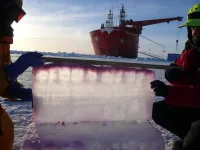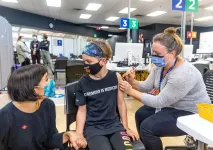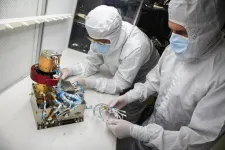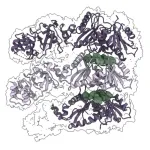(Press-News.org) Polar sea ice is ever-changing. It shrinks, expands, moves, breaks apart, reforms in response to changing seasons, and rapid climate change. It is far from a homogenous layer of frozen water on the ocean’s surface, but rather a dynamic mix of water and ice, as well as minute pockets of air and brine encased in the ice.
New research led by University of Utah mathematicians and climate scientists is generating fresh models for understanding two critical processes in the sea ice system that have profound influences on global climate: the flux of heat through sea ice, thermally linking the ocean and atmosphere, and the dynamics of the marginal ice zone, or MIZ, a serpentine region of the Arctic sea ice cover that separates dense pack ice from open ocean.
In the last four decades since satellite imagery became widely available, the width of the MIZ has grown by 40% and its northern edge has migrated 1,600 kilometers northward, according to Court Strong, a professor of atmospheric sciences.
“It has also shifted toward the pole while the size of the sea ice pack has declined,” said Strong, a co-author on one of two studies published by U scientists in recent weeks. “Most of these changes have happened in the fall, around the time when sea ice reaches its seasonal minimum.”
A tale of two studies, one north and one south
This study, which adapts a phase transition model normally used for alloys and binary solutions on laboratory scales to MIZ dynamics on the scale of the Arctic Ocean, appears in Scientific Reports. A second study, published in the Proceedings of the Royal Society A and based on field research in the Antarctic, developed a model for understanding the thermal conductivity of sea ice. The issue cover featured a photo exposing regularly spaced brine channels in the bottom few centimeters of Antarctic sea ice.
Ice covering both polar regions has sharply receded in recent decades thanks to human-driven global warming. Its disappearance is also driving a feed-back loop where more of the sun energy’s is absorbed by the open ocean, rather than getting reflected back to space by ice cover.
Utah mathematics professors Elena Cherkaev and Ken Golden, a leading sea ice researcher, are authors on both studies. The Arctic study led by Strong examines the macrostructures of sea ice, while the Antarctic study, led by former Utah postdoctoral researcher Noa Kraitzman, gets into its micro-scale aspects.
Sea ice is not solid, but rather is more like a sponge with tiny holes filled with salty water, or brine inclusions. When the ocean water below interacts with this ice, it can set up a flow that allows heat to move more quickly through the ice, just as when you stir a cup of coffee, according to Golden. Researchers in the Antarctic study used advanced mathematical tools to figure out how much this flow boosts heat movement.
The thermal conductivity study also found that new ice, as opposed to the ice that remains frozen year after year, allows more water flow, thereby enabling greater heat transfer. Current climate models could be underestimating the amount of heat moving through the sea ice because they don’t fully account for this water flow. By improving these models, scientists can better predict how fast sea ice melts and how this affects the global climate.
While the aspects of ice investigated in the two studies are quite different, the mathematical principles for modeling them are the same, according to Golden.
“The ice not a continuum. It’s a bunch of floes. It’s a composite material, just like the sea ice with the tiny brine inclusions, but this is water with ice inclusions,” said Golden, describing the Arctic’s marginal ice zone. “It’s basically the same physics and math in a different context and setting, to figure out what are the effective thermal properties on the big scale given the geometry and information about the floes, which is analogous to giving detailed information about the brine inclusions at the sub-millimeter scale.”
Golden is fond of saying what happens in the Arctic does not stay in the Arctic. Changes in the MIZ are certainly playing out elsewhere in the world in the form of disrupted climate patterns, so it is critical to understand what it’s doing. The zone is defined as that part of the ocean surface where 15% to 80% is covered by sea ice. Where the ice cover is greater than 80% it is considered pack ice and less than 15% it’s considered to be the outer fringes of open ocean.
A troubling picture from space
“The MIZ is the region around the edge of the sea ice, where the ice gets broken into smaller chunks by waves and melting,” Strong said. “Changes in the MIZ are important because they affect how heat flows between the ocean and atmosphere, and the behavior of life in the Arctic, from microorganisms to polar bears, and navigating humans.”
With the advent of quality satellite data beginning in the late 1970s, scientific interest in the MIZ has grown, since now its changes are easily documented. Strong was among those who figured out how to use imagery shot from space to measure the MIZ and document alarming changes.
“Over the past several decades, we’ve seen the MIZ widen by a dramatic 40%,” Strong said.
For years, scientists have scrutinized sea ice as a so-called “mushy layer.” As a metal alloy melts or solidifies from liquid, either way it passes through a porous or mushy state where the liquid and solid phases coexist. Freezing salt water is similar, resulting in a pure ice host with liquid brine pockets, which is particularly porous or mushy in the bottom few centimeters nearest the warmer ocean, with vertical channels called “chimneys” in mushy layer language.
Strong’s team tested whether previously modeled mushy layer physics could be applied to the vast reaches of the MIZ. According to the study, the answer is yes, potentially opening a fresh look at a part of the Arctic that is in constant flux.
In short, the study proposed a new way of thinking about the MIZ, as a large-scale phase transition region, similar to how ice melts into water. Traditionally, melting has been viewed as something that happens on a small scale, like at the edges of ice floes. But when the Arctic is viewed in its entirety, the MIZ can be seen as a broad transition zone between solid, dense pack ice and open water. This idea helps explain why the MIZ is not just a sharp boundary, but rather a “mushy” region where both ice and water coexist.
“In climate science, we often use very complex models. This can lead to skillful prediction, but can also make it difficult to understand what’s happening physically in the system,” Strong said. “The goal here was to make the simplest possible model that can capture the changes we’re seeing in the MIZ, and then to study that model to gain insight into how the system works and why it’s changing.”
The focus in this study was to understand the MIZ’s seasonal cycle. The next step will be applying this model to better understand what drives MIZ trends observed over the past few decades.
The study “Homogenization for convection-enhanced thermal transport in sea ice” appeared Aug. 28 in the journal Proceedings of the Royal Society A. Co-authors include Rebecca Hardenbrook of Dartmouth University and Huy Dinh, N. Benjamin Murphy, Elena Cherkaev and Jingyi Zhu of the U’s Department of Mathematics. The Arctic study titled, “Multiscale mushy layer model for Arctic marginal ice zone dynamics,” appeared Sept. 3 in Scientific Reports. Funding for this research came from the National Science Foundation and the U.S. Office of Naval Research.
END
Unpacking polar sea ice
Utah mathematics and climate researchers build new models for understanding sea ice, which is not as solid as you might think.
2024-10-02
ELSE PRESS RELEASES FROM THIS DATE:
U of M Medical School receives $3.2M to study drivers of chronic low back pain
2024-10-02
MINNEAPOLIS/ST. PAUL (10/2/2024) — The University of Minnesota Medical School recently received a five-year, $3.2 million R01 grant from the National Institute of Arthritis and Musculoskeletal and Skin Diseases for a project that will study the epigenetic factors of low back pain. Low back pain affects 619 million people globally and is the single leading cause of disability worldwide, according to the World Health Organization. This chronic pain impacts people of all ages and can affect quality of life and mental well-being.
Epigenetics refers to biological processes that affect how genes work without altering the DNA itself. These changes can ...
UT Health San Antonio School of Nursing’s Caring for the Caregiver program earns national award
2024-10-02
SAN ANTONIO, Oct. 2, 2024 – The Caring for the Caregiver Program (C4CP) of the School of Nursing at The University of Texas Health Science Center at San Antonio (UT Health San Antonio) has earned a national award for its comprehensive education and support for families living with dementia.
The 5TH Annual Maude’s Awards were announced in Seattle, rewarding innovations that enrich the quality of life for persons living with Alzheimer’s disease and related dementias, as well as their care partners. The award was created in 2019 by Richard Ferry, co-founder of management consulting firm Korn Ferry International, ...
People infer the past better than the future, study finds
2024-10-02
If you started watching a movie from the middle without knowing its plot, you’d likely be better at inferring what had happened earlier than predicting what will happen next, according to a new Dartmouth-led study published in Nature Communications.
Prior research has found that humans are usually equally good at guessing about the unknown past and future. However, those studies have relied on very simple sequences of numbers, images, or shapes, rather than on more realistic scenarios.
"Events in real life have complex associations relating to time that haven't typically been captured in past work, so we wanted to explore how people make inferences ...
Sexual and gender minorities more likely to experience life dissatisfaction, isolation, stress
2024-10-02
FOR IMMEDIATE RELEASE
Wednesday, October 2, 2024
Contact:
Jillian McKoy, jpmckoy@bu.edu
Michael Saunders, msaunder@bu.edu
##
Sexual and Gender Minorities More Likely to Experience Life Dissatisfaction, Isolation, Stress
A new study found that sexual and gender minority adults in the US were more likely to report multiple social risk factors than heterosexual and cisgender adults, highlighting the need for policies that advance the health and socioeconomic well-being of these groups.
Until last year, few national surveys collected information about the prevalence of social risk factors—individual-level adverse experiences such as food insecurity ...
In surgery for localized muscle-invasive bladder cancer, extended lymph node removal offers no survival benefit but does increase morbidity
2024-10-02
The SWOG S1011 randomized phase 3 trial found no significant improvement in disease-free or overall survival but a higher rate of grade 3-4 adverse events and an increased risk of death in the 90 days after surgery. The findings, published in NEJM, should establish a standard bilateral pelvic lymphadenectomy that includes the external and internal iliac and obturator nodes as the standard of care for these patients.
Final results from the SWOG S1011 randomized phase 3 clinical trial, just published ...
“Nature-First Cities”, a new book explores how to invite nature back home, without evicting people
2024-10-02
A new book from Cam Brewer, Herb Hammond and SFU Resource and Environmental Management director, Sean Markey explores a nature-directed approach to stewardship that enhances cities, restores our relationships with nature and helps to rebuild our relationships with each other.
Situated in the understanding that both people and nature belong in urban spaces, and guided by principles of nature, equity and density, Nature- First Cities offers a vision for reestablishing our relationship with nature in cities.
This book is of particular interest to urban planners, ...
Health care site- and patient-related factors influencing COVID-19 vaccination completion rates
2024-10-02
The COVID-19 vaccine, introduced in December 2022, played a critical role in reducing mortality and morbidity related to the pandemic globally. Yet, by 2023, only 70% of the US population had completed the primary vaccination series. While factors such as race/ethnicity, socio-economic status, geography and political affiliations have been linked to vaccination rates, its relationship with characteristics of health care delivery sites like community health care centers (CHCs), has not been explored. CHCs, which provide comprehensive primary care to low-income populations, including COVID-19 vaccines, are key players in ...
SwRI-built solar wind plasma sensor to help track space weather
2024-10-02
SAN ANTONIO — October 2, 2024 —The Southwest Research Institute-developed Solar Wind Plasma Sensor (SWiPS) has been delivered and integrated into a National Oceanic and Atmospheric Administration (NOAA) satellite dedicated to tracking space weather. SWiPS will measure the properties of ions originating from the Sun, including the very fast ions associated with coronal mass ejections that interact with the Earth’s magnetic environment.
NOAA’s Space Weather Follow On-Lagrange 1 (SWFO-L1) satellite will orbit the Sun at ...
Filament structure activates and regulates CRISPR-Cas ‘protein scissors’
2024-10-02
CRISPR-Cas systems help to protect bacteria from viruses. Several different types of CRISPR-Cas defense systems are found in bacteria, which differ in their composition and functions. Among them, the most studied proteins today are Cas9 and Cas12, also known as DNA or ‘gene scissors’, which have revolutionized the field of genome editing, enabling scientists to edit genomes and correct disease-causing mutations precisely.
Researchers from the Institute of Biotechnology at the Life Sciences Center of Vilnius University – ...
Environmental quality of life benefits women worldwide
2024-10-02
Global evidence has revealed that women’s environmental quality of life is key to their overall quality of life and health, according to a study published October 2, 2024, in the open-access journal PLOS ONE by Suzanne Skevington from the University of Manchester, U.K., and colleagues.
Gender inequalities in health-related quality of life are generally few and small, even in large surveys. Yet many generic measures limit assessment to quality of life overall and its physical and psychological dimensions, while overlooking internationally important environmental, ...
LAST 30 PRESS RELEASES:
Injectable breast ‘implant’ offers alternative to traditional surgeries
Neuroscientists devise formulas to measure multilingualism
New prostate cancer trial seeks to reduce toxicity without sacrificing efficacy
Geometry shapes life
A CRISPR screen reveals many previously unrecognized genes required for brain development and a new neurodevelopmental disorder
Hot flush treatment has anti-breast cancer activity, study finds
Securing AI systems against growing cybersecurity threats
Longest observation of an active solar region
Why nail-biting, procrastination and other self-sabotaging behaviors are rooted in survival instincts
Regional variations in mechanical properties of porcine leptomeninges
Artificial empathy in therapy and healthcare: advancements in interpersonal interaction technologies
Why some brains switch gears more efficiently than others
UVA’s Jundong Li wins ICDM’S 2025 Tao Li Award for data mining, machine learning
UVA’s low-power, high-performance computer power player Mircea Stan earns National Academy of Inventors fellowship
Not playing by the rules: USU researcher explores filamentous algae dynamics in rivers
Do our body clocks influence our risk of dementia?
Anthropologists offer new evidence of bipedalism in long-debated fossil discovery
Safer receipt paper from wood
Dosage-sensitive genes suggest no whole-genome duplications in ancestral angiosperm
First ancient human herpesvirus genomes document their deep history with humans
Why Some Bacteria Survive Antibiotics and How to Stop Them - New study reveals that bacteria can survive antibiotic treatment through two fundamentally different “shutdown modes”
UCLA study links scar healing to dangerous placenta condition
CHANGE-seq-BE finds off-target changes in the genome from base editors
The Journal of Nuclear Medicine Ahead-of-Print Tip Sheet: January 2, 2026
Delayed or absent first dose of measles, mumps, and rubella vaccination
Trends in US preterm birth rates by household income and race and ethnicity
Study identifies potential biomarker linked to progression and brain inflammation in multiple sclerosis
Many mothers in Norway do not show up for postnatal check-ups
Researchers want to find out why quick clay is so unstable
Superradiant spins show teamwork at the quantum scale
[Press-News.org] Unpacking polar sea iceUtah mathematics and climate researchers build new models for understanding sea ice, which is not as solid as you might think.






